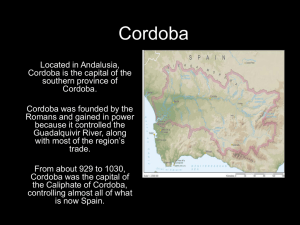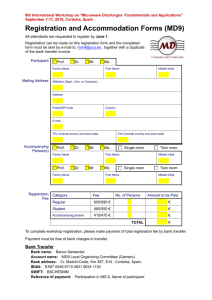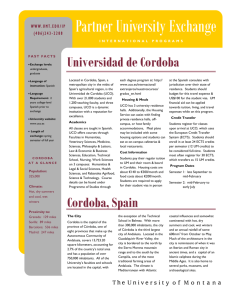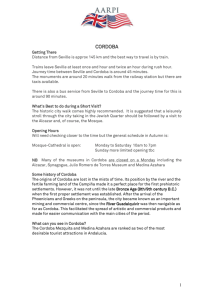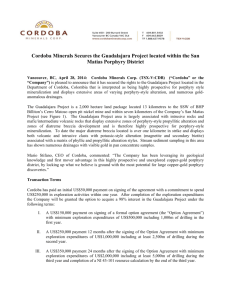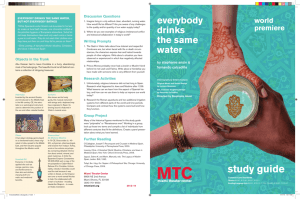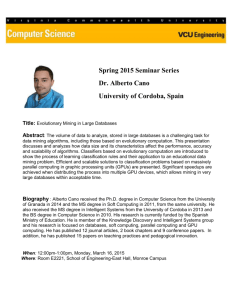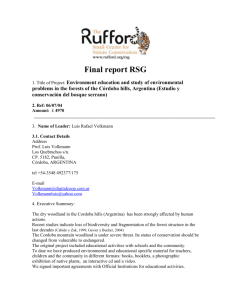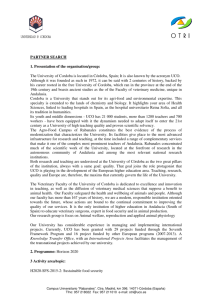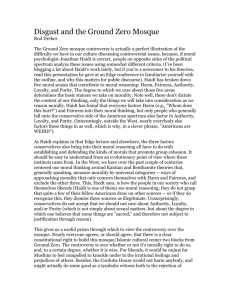CORDOBA AND ITS PARADOR
advertisement
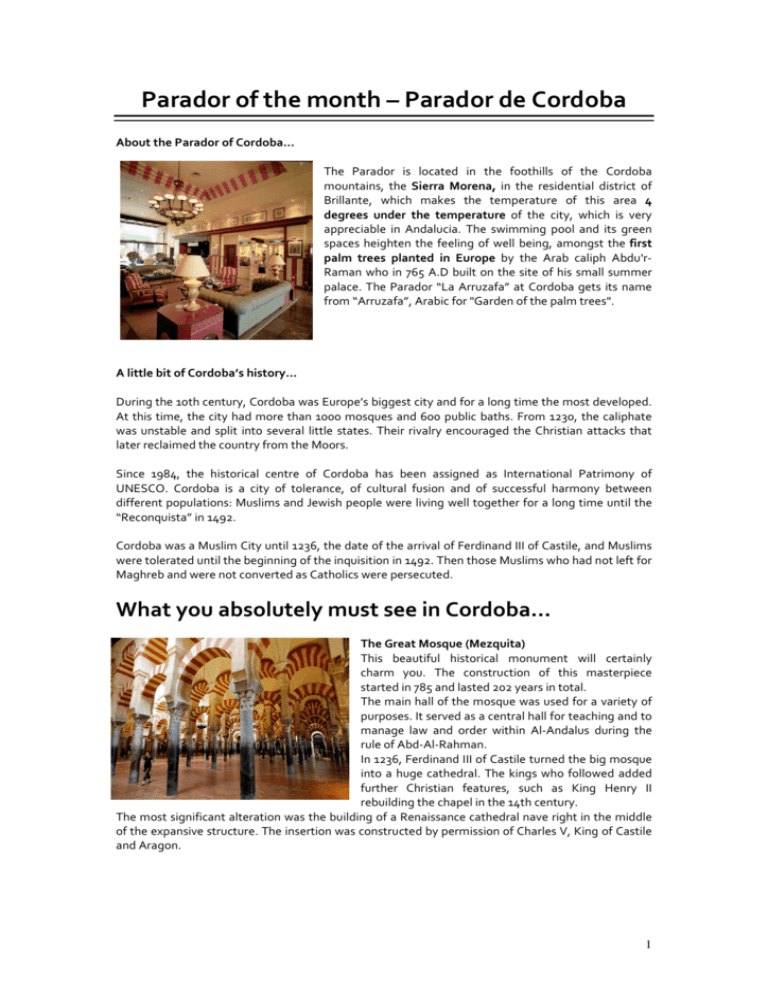
Parador of the month – Parador de Cordoba About the Parador of Cordoba… The Parador is located in the foothills of the Cordoba mountains, the Sierra Morena, in the residential district of Brillante, which makes the temperature of this area 4 degrees under the temperature of the city, which is very appreciable in Andalucia. The swimming pool and its green spaces heighten the feeling of well being, amongst the first palm trees planted in Europe by the Arab caliph Abdu'rRaman who in 765 A.D built on the site of his small summer palace. The Parador “La Arruzafa” at Cordoba gets its name from “Arruzafa”, Arabic for "Garden of the palm trees". A little bit of Cordoba’s history… During the 10th century, Cordoba was Europe’s biggest city and for a long time the most developed. At this time, the city had more than 1000 mosques and 600 public baths. From 1230, the caliphate was unstable and split into several little states. Their rivalry encouraged the Christian attacks that later reclaimed the country from the Moors. Since 1984, the historical centre of Cordoba has been assigned as International Patrimony of UNESCO. Cordoba is a city of tolerance, of cultural fusion and of successful harmony between different populations: Muslims and Jewish people were living well together for a long time until the “Reconquista” in 1492. Cordoba was a Muslim City until 1236, the date of the arrival of Ferdinand III of Castile, and Muslims were tolerated until the beginning of the inquisition in 1492. Then those Muslims who had not left for Maghreb and were not converted as Catholics were persecuted. What you absolutely must see in Cordoba… The Great Mosque (Mezquita) This beautiful historical monument will certainly charm you. The construction of this masterpiece started in 785 and lasted 202 years in total. The main hall of the mosque was used for a variety of purposes. It served as a central hall for teaching and to manage law and order within Al-Andalus during the rule of Abd-Al-Rahman. In 1236, Ferdinand III of Castile turned the big mosque into a huge cathedral. The kings who followed added further Christian features, such as King Henry II rebuilding the chapel in the 14th century. The most significant alteration was the building of a Renaissance cathedral nave right in the middle of the expansive structure. The insertion was constructed by permission of Charles V, King of Castile and Aragon. 1 The Arab baths Water is the most important element in the Islamic culture and the city of Cordoba is organised around this element. As the ex-capital of the Al-Andalus kingdom, Cordoba had its own public baths. They are divided into three parts: - The cold water room - The temperate water room - The hot water room (with the Hammam) You may like to spend several hours in this beautiful place. You can enjoy the traditional, relaxing Arabic music inside as you sip traditional peppermint tea. The rates include a 15 minute massage by local professional masseurs and they will ask you for your preference of massage oil. Alcázar of the Christian Monarchs The fortress served as one of the primary residences of Isabella I of Castile and Ferdinand II of Aragon during the Reconquista. The best time for visiting the Alcazar is springtime because of the thousands of flowers, orange and lemon trees decorating the city of Cordoba and its fortress’ gardens. If you feel energetic, you can climb the stairs of the fortress and you will enjoy the view of the city that the Catholic kings had. You can also walk through the gardens, see their attractive fountains and appreciate the site like the Kings used to. The Roman Bridge and the “Paseo del Guadalquivir” This is definitely the walk to do in Cordoba. The best time to do it is the evening when the sun is going down. You should know that the Guadalquivir in Cordoba is a natural reserve and at this time of the day you would be able to hear all the birds that are living there. The mixture of the lights of the Mezquita, the birds and the noise of the river passing under the bridge will put a spell on you. The Madinah al-Zahra archaeological site Al Madinah al-Zahra was an Arabic Medieval town located about 5 kilometres from Córdoba. Work on excavating its ruins started in the 1910’s. Only about 10 percent of the 112 sites have been excavated and restored so far. Caliph Abd ar-Rahman III of Córdoba had built the city between 936 and 940, which flourished for approximately 80 years. After he had proclaimed himself caliph in 928, establishing the independent 2 Umayyad Caliphate in the West, he decided to show his subjects and the world his power by building a palatial-city 5-km from Córdoba. The largest known city built from scratch in Western Europe, it would be described by travellers from northern Europe and from the East as a dazzling series of palaces full of treasures never seen before. Around 1010, Madinat al-Zahra was sacked during the civil war that led to the dissolution of the Caliphate of Cordoba. The raid effectively wiped the city off the map for a millennium. The Almodovar Castle The “Castillo de Almodovar” (Almodóvar Castle), is located 22 kilometres from Cordoba in the municipality of Almodóvar del Río. The magnificent style of this construction, set in an amazing location, has traces of multiple cultures such as the Moslem and the Christian. Discover the beauty of its walls, of its towers (the square tower, the round tower and the Homage tower), the “Patio de Armas” (Weapons Courtyard) and the mystery of its underground dungeons, the passages and other underground elements. There is a legend in the Castle. Many people who worked in the Castle and people from the small village nearby, Almodovar del Rio, could see and hear, the same night each year, a woman walking and crying by the battlements of the castle. Also, they could hear a man screaming from the dungeons. What is happening in Cordoba? There are lots of events that bring Cordoba to life, especially during the springtime, the most pleasant season of the year. Holy Week (Easter) The week before Easter, lots of processions representing diverse religious scenes are organised. Every church has its own procession and the routes are carefully planned. It is fascinating to observe the behaviour of the Andalusian people during these processions. The streets are full, especially on Maundy Thursday. Everybody is waiting before the processions to arrive by eating “pipas” (sunflower seeds). The ground is sprinkled with them and all generations are fervent followers of these small appetisers. 3 The May Crosses In Cordoba, after the festivities of the Holy Week that are celebrated everywhere in Spain, the local celebrations take over. They open with the contest of the May Crosses, which runs for 2 weeks between April and May. This demonstration, which celebrates the spring, comes from on an ancestral religious tradition. The inhabitants raise crosses covered with flowers everywhere in the city. This celebration is the opportunity for everyone to meet in the streets around these famous crosses decorated with flowers to have a drink, dance and sing to the rhythm of traditional Spanish music such as flamenco or sevillanas. The Patios From 6 to 18 May a sweet perfume of flowers glides over the historical centre of Cordoba. It is the season of the Patios’ contest decorated with flowers in the old district of Juderia. The owners decorate their patios with flowers and open them to the public. This is a marvellous opportunity to discover usually inaccessible places of the city. A jury passes through every patio to classify them. The Feria May ends with the “Feria” of Cordoba. Animation and atmosphere are guaranteed. An immense carnival begins outside the city. “Casetas” are built next to each other to receive the visitors during the whole period of the feria. This is a real opportunity to try flamenco and sevillanas, which are the most important dances during this event. You can taste and drink typical Spanish products such as local tapas and various wines of the region. Event planner: Jan Feb Mar Apr May Jun Jul Aug Sep Oct Nov Holy week The May Crosses The Patios The Feria The Corridas 4 Dec
